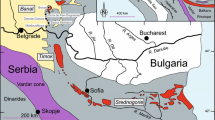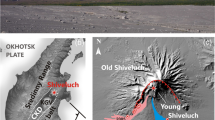Abstract
The epizonal, Tertiary Lilloise layered intrusion (5–9 km diameter) has a well developed amphibolitised basalt aureole, several hundred metres wide. The sequence of main cumulate minerals is olivine, augite, plagioclase, amphibole (Ti-hornblende to hastingsite), with amphibole first appearing as an intercumulus mineral about 2000 m below the present top of the intrusion. The range of δD and δ18O values (SMOW) of amphiboles and biotites from early intercumulus, and cumulus minerals and late pegmatites is very narrow, -70 to -88‰ and +4.3 to 5.5‰ respectively. Amphiboles or whole rocks from the basaltic country rocks change from δD= -85‰ near the contact to -116 in the outer part of the aureole, and to -118 in the non-metamorphosed basalts up to 9km away. All basalts are depleted in 18O relative to “normal” values with the largest depletion (up to 2–3‰) in the outer part of the aureole. Meteoric water did not interact with either the magma or the hot plutonic rocks. This is in contrast to the results from most other plutonic complexes in the North Atlantic Tertiary igneous province (Skaergaard, Kangerdlugssuaq, Skye, etc.) many of which were similarly emplaced into basaltic country rocks. A meteoric-hydrothermal convective system was established in the basalts including the inner contact zone prior to the complete crystallisation of the Lilloise magma. The inner part of the aureole was finally modified by magmatic-hydrothermal fluids which evolved non explosively from the Lilloise magma. The meteoric-hydrothermal system in the outer part of the aureole, with integrated water/rock ratios of about 0.2 (atom % oxygen), did not collapse in on the hot pluton or inner contact metabasalts. Several factors may have reduced the permeability of the basalt country rocks. The emplacement of dykes prior to the Lilloise intrusion and possible associated weak hydrothermal activity could have restricted circulation of meteoric water; major fracture permeability was not generated during the quiet non-explosive crystallisation history of the Lilloise single magma pulse; metasomatism and alteration accompanying the magmatic-hydrothermal fluids may have reduced permeabilities in the inner aureole. Meteoric waters, however, did enter locally, at a very late stage, during low temperature serpentinisation of periodotite.
Similar content being viewed by others
References
Anderson, A.T., Jr., Clayton, R.N., Mayeda, T.K.: Oxygen isotope thermometry of mafic igneous rocks. J. Geol. 75, 323–332 (1971)
Arnason, B., Sigurgeirsson, T.: Deuterium content of water vapour and hydrogen in volcanic gas at Surtsey, Iceland. Geochim. Cosmochim. Acta 32, 807–813 (1968)
Bottinga, Y., Javoy, M.: Oxygen isotope partitioning among the minerals in igneous and metamorphic rocks. Rev. Geophys. Space Physics 13, 401–418 (1975)
Brown, P.E.: A layered plutonic complex of alkali basalt parentage: the Lilloise intrusion, east Greenland. J. Geol. Soc. Lond. 129, 405–418 (1973)
Craig, H., Lupton, J.E.: Primordial neon, helium and hydrogen in oceanic basalts. Earth Planet. Sci. Lett. 31, 369–385 (1976)
Ernst, W.G.: Minerals, rocks and inorganic materials: Vol. 1, Amphiboles. Berlin-Heidelberg-New York: Springer 1968
Forester, R.W., Taylor, H.P., Jr.: 18O-depleted igneous rocks from the Tertiary complex of the Isle of Mull, Scotland. Earth Planet. Sci. Lett. 32, 11–17 (1976)
Forester, R.W., Taylor, H.P., Jr.: 18O/16O, D/H and 13C/12C studies of the Tertiary igneous complex of Skye, Scotland. Am. J. Sci. 277, 136–177 (1977)
Friedman, I.: Water and deuterium in pumice from the 1959–60 eruption of Kilauea volcano, Hawaii. U.S.G.S. Profess. Papers 575-B, B120-B127 (1967)
Garlick, G.D.: Oxygen isotope fractionation in igneous rocks. Earth Planet. Sci. Lett. 1, 361–368 (1966)
Kokubu, N., Mayeda, T., Urey, H.C.: Deuterium content of minerals, rocks and liquid inclusion from rocks. Geochim. Cosmochim. Acta 21, 247–256 (1961)
Liou, J.G., Kuniyoshi, S., Ito, K.: Experimental studies in the phase relations between greenschist and amphibolite in a basaltic system. Am. J. Sci. 274, 613–632 (1974)
Miyashiro, A.: Metamorphism and metamorphic belts, London: George, Allen and Unwin 1973
Miyashiro, A.: Shido, F., Ewing, M.: Diversity and origin of abyssal tholeiite from the Mid.Atlantic Ridge near 24 ° and 30 ° N latitude. Contrib. Mineral. Petrol. 23, 38–52 (1969)
Moore, J.G.: Water content of basalt erupted on the ocean floor. Contrib. Mineral. Petrol. 28, 272–279 (1970)
Muehlenbachs, K., Anderson, A.T., Jr., Sigvaldason, G.E.: Low-O18 basalts from Iceland. Geochim. Cosmochim. Acta 38, 577–588 (1974)
O'Neil, J.R., Taylor, H.P., Jr.: The oxygen isotope and cation exchange chemistry of feldspars. Am. Mineralogist 52, 1414–1437 (1967)
Pankhurst, R.J., Beckinsale, R.D., Brooks, C.K.: Strontium and oxygen isotope evidence relating to the petrogenesis of the Kangerdlugssuaq alkaline intrusion, east Greenland. Contrib. Mineral. Petrol. 54, 17–42 (1976)
Reuter, J.H., Epstein, S., Taylor, H.P., Jr.: O18/O16 ratios of some chondritic meteorites and terrestrial ultramafic rocks. Geochim. Cosmochim. Acta 29, 481–488 (1965)
Sheppard, S.M.F.: The identification of the origin of ore-forming solutions by the use of stable isotopes. In: Volcanic processes in ore genesis (M.J. Jones, ed.), pp. 25–411. Instn. Min. and Metall. and Geol. Soc. Lond. 1977
Sheppard, S.M.F., Dawson, J.B.: Hydrogen, carbon and oxygen isotope studies of megacryst and matrix minerals from Lesothan and South African kimberlites. Phys. Chem. Earth 9, 747–763 (1975)
Sheppard, S.M.F., Epstein, S.: D/H and 18O/16O ratios of minerals of possible mantle or lower crustal origin. Earth Planet. Sci. Lett. 9, 232–239 (1970)
Sheppard, S.M.F., Nielsen, R.L., Taylor, H.P., Jr.: Oxygen and hydrogen isotope ratios of clay minerals from porphyry copper deposits. Econ. Geol. 64, 755–777 (1969)
Sheppard, S.M.F., Nielsen, R.L., Taylor, H.P., Jr.: Hydrogen and oxygen isotope ratios in minerals from porphyry copper deposits. Econ. Geol. 66, 515–542 (1971)
Soper, N.J., Downie, C., Higgins, A.C., Costa, L.I.: Biostratigraphic ages of Tertiary basalts on the east Greeland continental margin and their relationship to plate separation in the Northeast Atlantic. Earth Planet. Sci. Lett. 32, 149–157 (1976)
Suzuoki, T., Epstein, S.: Hydrogen isotope fractionation between OH-bearing silicate minerals and water. Geochim. Cosmochim. Acta 40, 1229–1240 (1976)
Taylor, H.P., Jr.: The oxygen isotope geochemistry of igneous rocks. Contrib. Mineral. Petrol. 19, 1–71 (1968)
Taylor, H.P., Jr.: The application of oxygen and hydrogen isotope studies to problems of hydrothermal alteration and ore deposition. Econ. Geol. 69, 843–883 (1974)
Taylor, H.P., Jr.: Water/rock interactions and the origin of H2O in granitic batholiths. J. Geol. Soc. Lond. 133, (in press) (1977)
Taylor, H.P., Jr., Epstein, S.: Relationship between O18/O16 ratios in co-existing minerals of igneous and metamorphic rocks, Part I: Principles and experimental results. Bull. Geol. Soc. Am. 73, 461–480 (1962)
Taylor, H.P., Jr., Forester, R.W.: Low-O18 igneous rocks from the intrusive complexes of Skye, Mull and Ardnamurchan, western Scotland. J. Petrol. 12, 465–497 (1971)
Taylor, H.P., Jr., Forester, R.W.: An oxygen and hydrogen isotope study of the Skaergaard intrusion and its country rocks, (abstract) Trans. Am. Geophys. Union 54, 500 (1973)
Wager, L.R.: Geological investigations in east Greenland, Pt. IV. The stratigraphy and tectonics of Knud Rasmussens Land and the Kangerdlugssuaq region. Medd. om Grønland 134, No. 5, 1–62 (1947)
Wager, L.R., Deer, W.A.: Geological investigations in east Greenland, Pt. III. The petrology of the Skaergaard intrusion, Kangerdlugssuaq, east Greenland. Medd. om Grønland 105, No. 4, 1–352 (1939)
Wenner, D.B., Taylor, H.P., Jr.: Oxygen and hydrogen isotope studies of the serpentiuisation of ultramafic rocks in oceanic environments and continental ophiolite complexes. Am. J. Sci. 273, 207–239 (1973)
Author information
Authors and Affiliations
Rights and permissions
About this article
Cite this article
Sheppard, S.M.F., Brown, P.E. & Chambers, A.D. The Lilloise intrusion, east Greenland: Hydrogen isotope evidence for the efflux of magmatic water into the contact metamorphic aureole. Contrib. Mineral. and Petrol. 63, 129–147 (1977). https://doi.org/10.1007/BF00398775
Received:
Accepted:
Issue Date:
DOI: https://doi.org/10.1007/BF00398775




